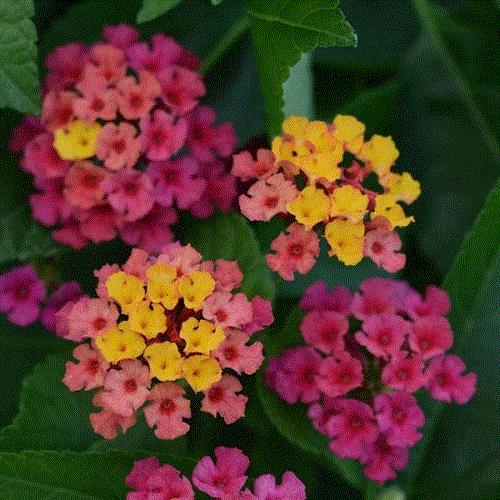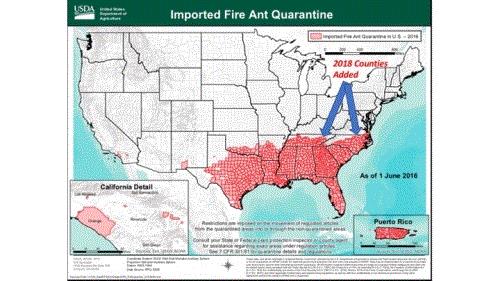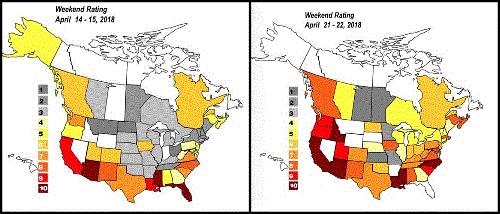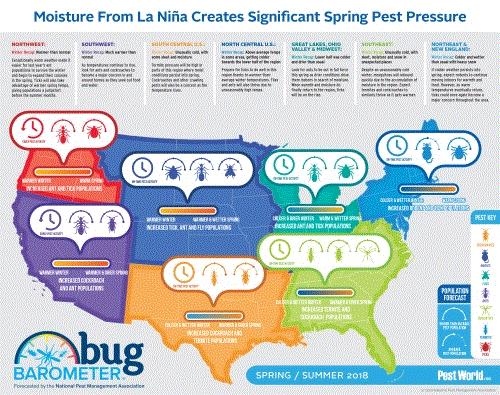University of Florida Releases Sterile Lantana
While possibly not big news nation-wide, Lantana camara has become quite the invasive species along the Atlantic (Florida) and Gulf of Mexico (Florida to Texas) coastlines. That’s why it’s pretty big news that Dr. Zhanao Deng, Professor of Ornamental Plant Breeding and Genetics at the University of Florida, has developed and released two completely sterile cultivars. Well, they were actually released last year, but they're really hitting the market this year. Named Bloomify Rose and Bloomify Red, these cultivars produce no viable pollen and they also produce no seed.

Bloomify Rose is one of two sterile cultivars developed and released by the University of Florida.
While they can be used as an annual north of Zone 9, they'll be perennial in Zones 9 south. Blooming nearly all season (or year in Zones 10 to 11), these two cultivars share many attributes with other lantana, including salt and drought tolerance (once established) and can be used as an indicator species for whitefly (we all can’t be perfect) if gardenia isn’t available. I also like the size, as neither cultivar gets much larger than 24-in. tall under ideal conditions.
Kudos to Dr. Deng and his colleagues at the University of Florida for filling a need in the industry and providing further proof that us plant breeders can make magic happen.

H-2B Still in Limbo
It’s been about five weeks since El Presidente Trump authorized the release (as part of the appropriations bill) of 69,000 additional H-2B visas. However, to date, there hasn’t been much to report from the Department of Homeland Security and Department of Labor as to when these visas will be released. That has many of you, particularly on the landscape contracting side, pretty fired up. In fact, most folks I talk to have all but given up on the notion of seeing applications approved—partially because it’s so late in the season.
While quite ambiguous, Secretary of Agriculture Sonny Perdue has recently been hinting at a new immigrant labor policy, most recently just this Tuesday. What that will look like and when it will be released for us to see is a mystery, and I for one don’t see it happening before the November elections. But I could be wrong (again).
As for now, what can you do to try and grease the H-2B wheels? Both AmericanHort and the National Association for Landscape Professionals have advocacy sites where you can share your story and send correspondence to your representatives. It’s all about being the loudest voice in the room when it comes to getting attention in Washington D.C.

The Fire Ant Quarantine Grows—A Little
Unfortunately, the fire any quarantine line continues to creep northward, even though the sweet tea and cheese grits line aren’t keeping pace. USDA-APHIS recently announced that the quarantine grew by three and a half counties. They include Warren Co. in North Carolina, as well as Cumberland, Hamblen, Jefferson and southern Trousdale Cos. in Tennessee.

While USDA hasn't updated their map (shocking, I know), I've indicated with arrows where the added counties are located.
While not large in number, these counties are home to some significant nursery (and retail) operations. For example Payne Nursery in Sparta, Tennessee, and Riverdale Nursery in Knoxville, Tennessee.
Is Spring Actually Here?
If you've kept up with Chris Beytes’ weekend ratings thus far in 2018 (you’ll need to subscribe to Acres Online to receive them), you’ll know that “sales suck” has been a common theme nationwide and into Canada early this season, with signs of hope the weekend of April 21-22.
I’m guessing last weekend was even better, but it would be great if you could send Chris what your impressions are after each weekend. Grower or garden center, doesn’t matter. Please send Chris your weekend a score from 1 (blah) to 10 (brilliant!) at beytes@growertalks.com.

Sales weren't great the wekend of April 14-15 (left), but trended up the weekend of April 21-22. The latest rankings for April 28-29 just came out and are in the Acres Online newsletter.
Be sure to include the state(s) and/or province(s) where you do business, and any notes of the weekend you'd like to share. Chris compiles the data using his abacus and presents it in Acres Online.
And if you were wondering—we in Georgia held our annual "Skip Spring" party this past Tuesday and will reside in the mid-80s until May, whereby we'll enter the humidity season when we throw on water vapor to make the day truly amazing to work outside. But I’m not complaining at all!

Grazon Season is Here
I head over to my local Southern States about once a week to ask what’s selling. About two weeks ago (here in Georgia), GrazonNext HL and Grazon P&D started flying off the shelves. This week, folks started sending pictures and wondering what the heck is happening.
But let me back up a bit: GrazonNext HL is a broadleaf herbicide containing two active ingrediants—aminopyralid and 2,4-D, whereas Grazon P&D contains picloram and 2,4-D.
In both products, either of these active ingredients would do a number on many species of broadleaf ornamentals (example list can be found here). Together they pose a significant risk. I’m going to tell you now, if you have neighbors with pastureland (where GrazonNext HL or Grazon P&D is typically applied), you should have a friendly conversation with them about the necessity to stay “on label” when applying this herbicide.
Why, you may ask? Well, this year I've heard from growers and landscape contractors who've seen massive damage from aerial drift and boom application drift—in one case nearly 500 yards through a pine plantation. I’ve seen damage from runoff, likely due to overapplication, which found its way to a surface irrigation pond used to irrigate nursery stock. I’ve seen misapplication to lawn turf that killed mature trees.
In all of these cases, two factors make this herbicide really problematic for ornamental growers and landscape contractors. First, it only takes 10 parts per billion in soil or irrigation water to cause damage. Second, it has a half-life in soil of up to 300 days (although typically much less if it drifts in). Even if it doesn’t kill ornamentals, when plants receive non-lethal doses, it can take two to three years for plants to grow out.
Scared yet? Well, go have that polite talk with the hobby farmer or commercial rancher today. And maybe I’m paranoid, but I’d record the audio so it’s perfectly clear.

The Bug Barometer
While it sounds like a fantastic science fiction B-rated movie destined for Mystery Science Theater 3000, I must admit that I recently stumbled upon The Bug Barometer. It’s not only real, but it's science based—or at least pest management professionals put on their prognosticating hats twice a year to gauge upcoming pest pressure. This mainly pertains to those pests that affect people and property (not plants), but some general parallels can be drawn to plant pests.

So what do the professionals say for spring into summer 2018? In short, it’s going to be a rather bad year for bugs. This can be attributed to decent rainfall across the entire U.S., minus the four-corners region. We shall see if this comes to pass, but regardless, kudos to the National Pest Management Association for making me giggle.
Styrax—Ohhh, Yes
I’m specifically showing Styrax japonicus (Japanese snowbell) some love here. Reaching a mature height of 30 ft. with a rounded form, this is another small- to medium-sized tree that I really like. After all, it’s got fragrant white blooms in April through June (depending on your location), clean foliage through the summer, decent yellow to red fall color and cool bark for winter interest.

While it's listed as hardy from Zone 5 to 9, I’ve seen good specimens in Zone 10 as well. It does prefer slightly acidic soils with moderate soil moisture. One flaw is that it definitely won't tolerate compacted soils (I tried this and it didn't turn out well), but otherwise it's a handsome tree with few pest or disease issues.
There are a few cultivars out there, but I generally see the species being grown and planted. Of the cultivars available, I’d recommend Emerald Pagoda, which has larger foliage and flowers. Or if you want light pink flowers, Rosea is my choice. Then there’s Pendula, which is a weeper (duh).

Our Wacky Wonderful World—Notes from the Edge of Sanity
Gracious, did I get some seriously ticked off emails about not mentioning Earth Day in my last newsletter! You would have thought I had sprayed herbicide on their favorite ornamental. Truth be told, I decided not to mention it because to me, every day is Earth Day. That and the fact that you pretty much had to be living in a fallout shelter since 1970 to not know about Earth Day. Although skipping the '80s would have been a good tradeoff ...
I will, however, take this opportunity to mention my favorite holiday of the year. No, it’s not Christmahannakwanzaka. It’s not Thanksgiving. It’s certainly not my birthday, which I stopped celebrating at 39. It’s Naked Gardening Day! That’s right, folks—the day when you can scare the hell out of your neighbors and prove to them once and for all that you have completely lost your mind! All while starting to work on that base tan that will be appreciated when pool/beach season arrives. Talk about killing two stones with one bird! So, this Saturday, regardless of atmospheric conditions, join me in celebrating this monumental holiday.
Just don’t send me pictures … please! There are some times when a thousand words is way better than a picture.
And remember that sunscreen is reccomended by the Skin Cancer Foundation. Plus, it makes you shine like The Rock.

Live authentic,

Matthew Chappell
Editor-at-Large
Nursery & Landscape Insider
This has been received by 29,906 of the hardest-working horticulturists in show business!
If you're interested in reaching 29,906 (and growing) clients who eagerly await every Nursery & Landscape Insider and surely read every word, contact Kim Brown ASAP and she'll hook you up. And spread the word... let's get to 30,000 readers!